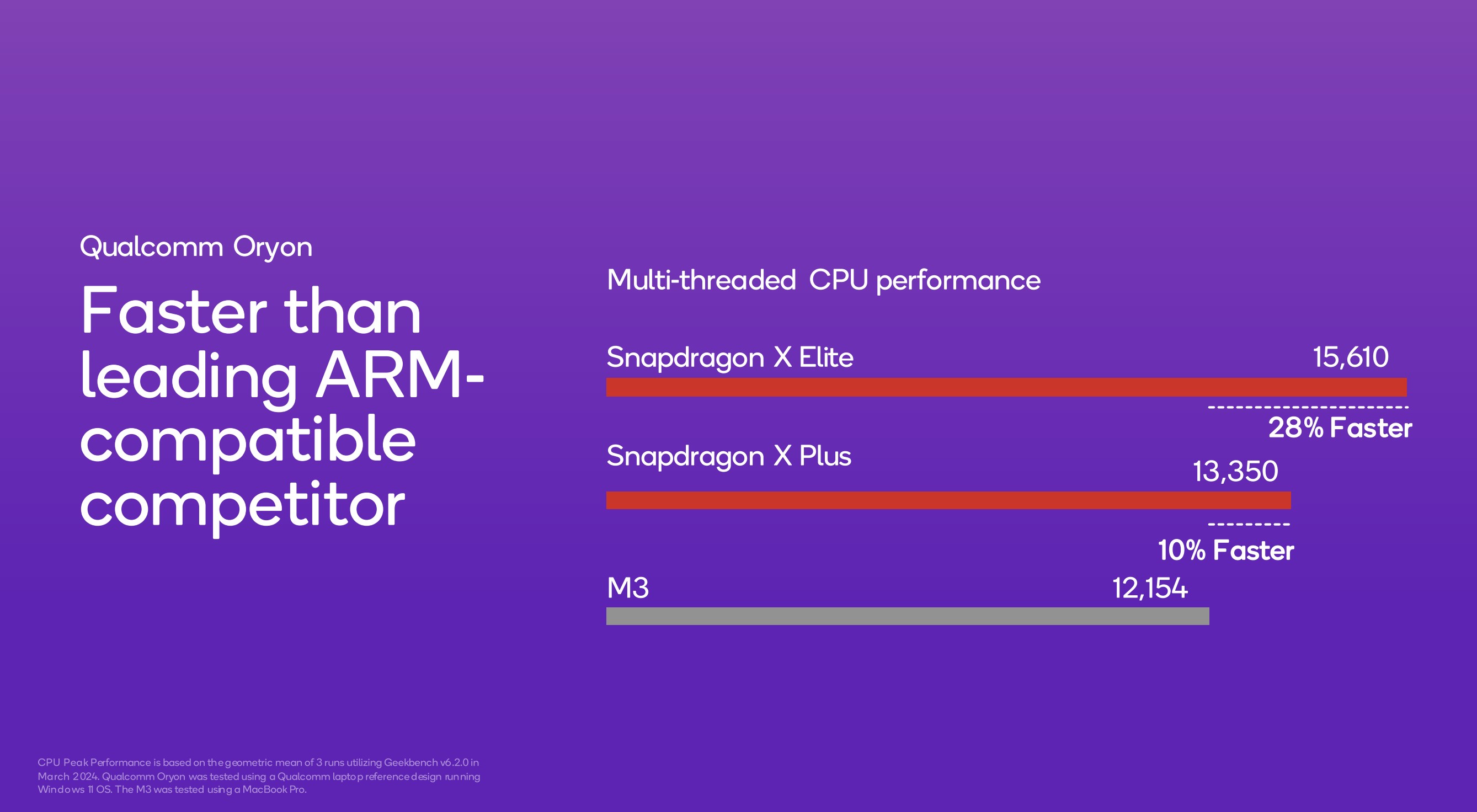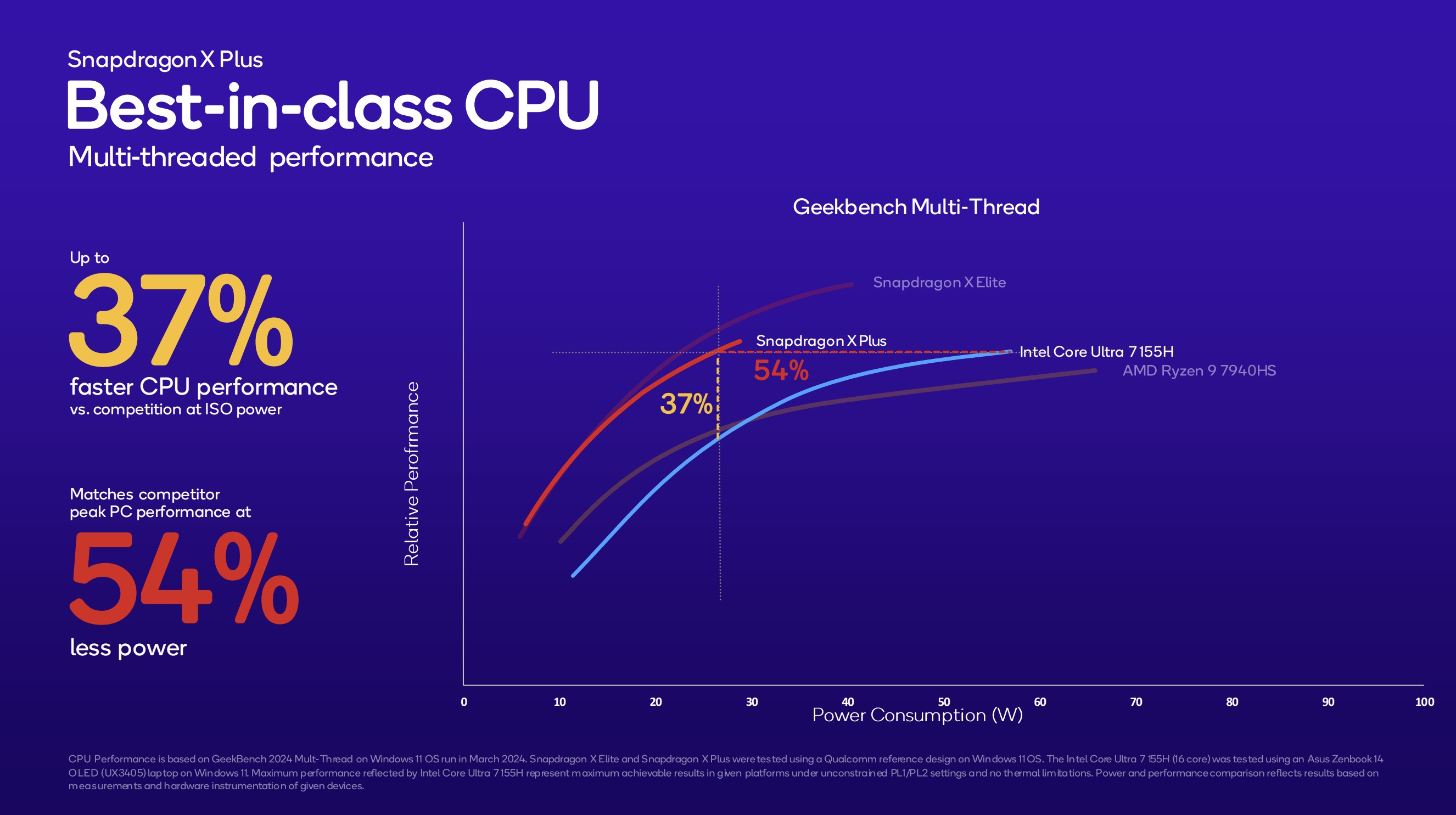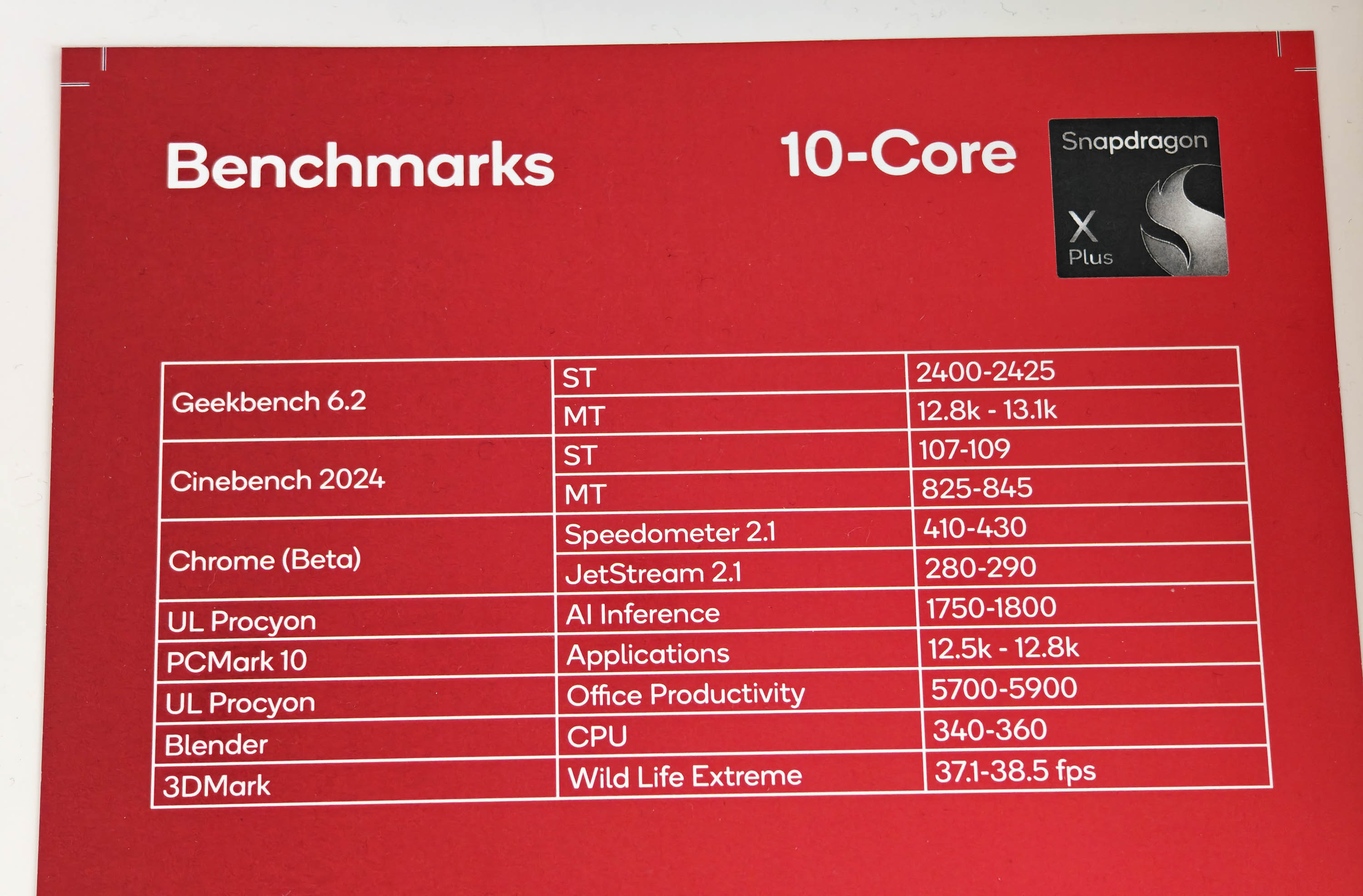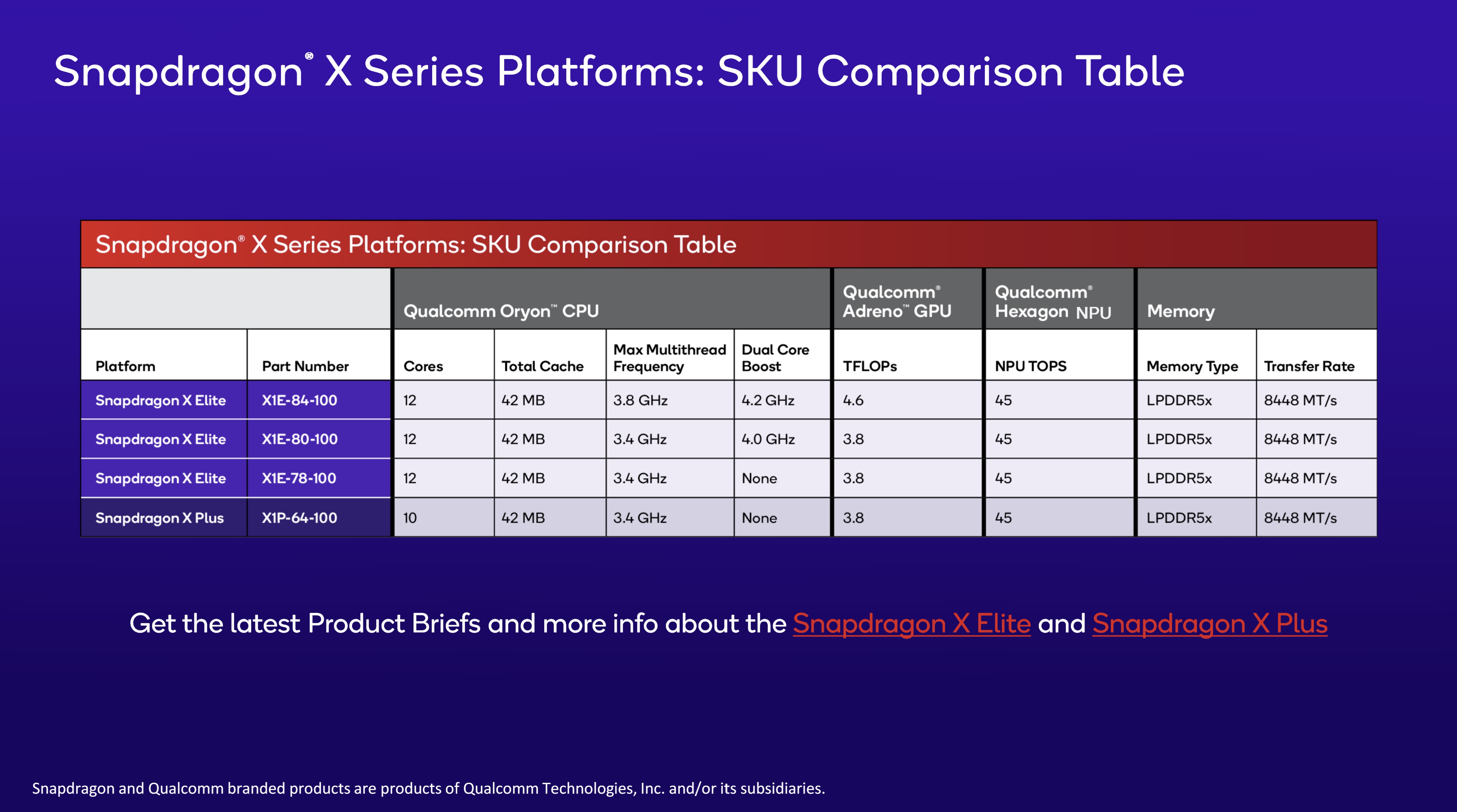
What you need to know
- Qualcomm has announced the new Snapdragon X Plus SoC (CPU, GPU, and NPU) for PCs alongside the previously announced Snapdragon X Elite.
- Based on the same platform, the X Plus drops from 12 cores to 10 and is slightly less powerful.
- Despite the reduced performance, Qualcomm claims the Snapdragon X Plus processor is still 10% faster on Geekbench v6.2.
- Qualcomm performed live benchmarking for media earlier this month to prove its prowess.
- Snapdragon X Plus launches at the same time as Snapdragon X Elite in “mid-2024.”
When Qualcomm introduced the Snapdragon X Elite chip for Windows 11 laptops, challenging Apple's dominance, it was emphasized that this chip was part of the Snapdragon X platform, suggesting the possibility of more processor variants. Typically, scaling the Snapdragon X involves adding or removing cores, similar to the approach taken by Apple, Intel, and AMD with their processors.
This prediction proved accurate as Qualcomm announced the Snapdragon X Plus SoC (System on Chip). The chip includes the Oryon CPU, Adreno GPU, and Hexagon NPU and is slated for a June release alongside the Snapdragon X Elite.
Utilizing the same 4nm architecture, the Snapdragon X Plus has 10 cores, compared to the 12 of the X Elite. Despite this, it maintains the same 42MB cache and a robust 45 TOPS NPU, surpassing Apple’s M3 (18 TOPS), Intel Core Ultra (10 TOPS), and AMD Ryzen 8040 (16 TOPS) in AI performance, making it the fastest AI PC processor to date.
The maximum multithread frequency stands at 3.4GHz across all ten cores without a dual-core boost.

In contrast, the premier X1E-84-100 Snapdragon X Elite, which is the highest of the three tiers, operates at 3.8GHz with two cores that can boost to 4.2GHz, and it delivers 4.6 TFLOPs through the Adreno GPU. The lower-tier Snapdragon X Elites, namely the X1E-80-100 and X1E-78-100, maintain a 12-core structure but differ in dual-core boost capabilities and offer 3.8 TFLOPs via the Adreno GPU, matching the GPU performance of the Snapdragon X Plus X1P-64-100 (of which Qualcomm has released only one SKU for the Snapdragon X Plus series).
All Qualcomm Snapdragon X processors support up to 64GB of LPDDR5x RAM at 8448 MT/s and come equipped with Wi-Fi 7, Bluetooth 5.4, as well as a range of ports including up to 3x USB4, 2x USB3.2 Gen 2, and 1x eUSB2.

Earlier this month, Qualcomm held a press event to showcase the capabilities of the Snapdragon X Plus through live benchmarking on laptops with the new SoC.
Similar to the Snapdragon X Elite, Qualcomm asserts that the benchmark figures and performance metrics accurately represent the chip's capabilities, allowing minimal room for dispute. Naturally, there is considerable anticipation of experiencing this technology in consumer laptops, which are expected to ship later this summer.
Who is the target market for Snapdragon X Plus?
Although Qualcomm has not specified the target audience for the Snapdragon X Plus, it is reasonable to assume that it will appear in more affordable laptops rather than the premium X Elite chips, which are expected to be exclusive to the most expensive models. However, the Snapdragon X Plus should not be viewed as the "budget" option within the Snapdragon X lineup but rather as a less costly alternative, similar to the difference between Intel’s Core Ultra 7 and Core Ultra 5 tiers.
Given that the Snapdragon X platform is adaptable, nothing prevents Qualcomm from reducing to 8 or even 6 cores to decrease cost and performance further. Similarly, Qualcomm could increase to 14 or 16 cores to compete with Apple’s M3 Pro and Max chips.
While Qualcomm remains silent regarding future processors, the company will probably expand the Snapdragon X range in both directions to meet different price points, satisfying laptop OEMs seeking more variety and consumers with varying budget constraints.
Snapdragon X Plus is still faster than Apple’s M3

Despite having fewer cores and a lower maximum frequency, Qualcomm asserts, through Geekbench 6.2—a widely recognized third-party benchmarking application—that its Snapdragon X Plus outperforms Apple's M3 processor, found in the latest MacBook Pro, with scores of 13,350 to 12,154, respectively. This 10% difference is notable, especially given that the Snapdragon X Plus is a first-generation platform and chip, in contrast to Apple's third-generation offering.
Certainly, when compared to the M3 Pro (15,281) and M3 Max (21,084), the Snapdragon X Plus falls short, although the Snapdragon X Elite (15,610) slightly surpasses Apple's M3 Pro in multithread performance.
The intriguing prospect is what would occur if Qualcomm expanded its Snapdragon X platform from 12 to 16 cores, matching Apple's high-end M3 Max. Based on current figures, Qualcomm would likely come out ahead. Nonetheless, it remains to be seen whether Qualcomm will make this advancement before Apple transitions to its M4 series.
Intel and AMD are also no match for the Snapdragon X Plus

Setting aside Apple's processors, which set the standard for the industry, neither Intel nor AMD come close to the Snapdragon X Plus, much less the more potent X Elite.
Looking at Geekbench, the Snapdragon X Plus outperforms Intel's Core Ultra 7 155H and AMD's Ryzen 9 7940HS by 37% in multi-thread performance and by 28% in Cinebench 2024 (now optimized for ARM processors).
Furthermore, the Snapdragon X Plus surpasses these chips in efficiency, consuming 54% less power (Geekbench) and 39% less power (Cinebench) than the equivalent Intel and AMD chips.

The Core Ultra 7 155H is one of Intel’s top-tier processors for 2024 and is found in everything from gaming laptops to the Dell XPS 14 and XPS 16 (Intel also offers the beefier Core Ultra 9 185H and Core i9-14900HX, reserved for high-value gaming laptops and workstations).
Assuming Qualcomm’s numbers are accurate (and we see no reason to doubt them), the takeaway is that the Snapdragon X Plus will be one very fast chip that is leaps and bounds more efficient than anything Intel and AMD currently offer.
Soon: Snapdragon X Plus launches alongside X Elite

Perhaps more interestingly, Qualcomm is launching the Snapdragon X Plus processor simultaneously with the Snapdragon X Elite.
Qualcomm is historically known to announce its ARMS PC processors with a typical 8-month lead time instead of weeks. The company is bucking the trend here by launching all four chips (three Snapdragon X Elite SKUs and one Snapdragon X Plus) at the same time, meaning we should see a very wide variety of new laptops with both processors offering a better range of prices, features, and performance.
As to when we should see these new laptops, Qualcomm only notes "mid-2024," but we're expecting some news in late May from Microsoft for Surface Pro 10 and Surface Laptop 6, which are to be announced just before its annual BUILD conference and feature Qualcomm's latest processors.
Likewise, Qualcomm CEO Cristiano Amon will deliver a keynote speech at COMPUTEX 2024, which will take place between June 4th and June 7th.
If we had to bet, COMPUTEX would be a suitable venue for Qualcomm and its OEM partners to unveil their fleet of Snapdragon X-powered laptops, with commercial launches starting later in June.







